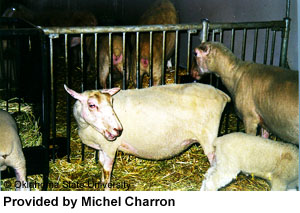Rideau Arcott Sheep
 The Rideau Arcott was originally a research breed selected for their lambing rate.
The Arcott breeding program began in 1966 when Agriculture Canada's Animal Research
Centre in Ottawa began expanding its mixed flock of Shropshire, Suffolk and OS sheep. One of the goals was to create a breed which reproduced rapidly. This
breed could be used to accelerate genetic and other sheep research.
The Rideau Arcott was originally a research breed selected for their lambing rate.
The Arcott breeding program began in 1966 when Agriculture Canada's Animal Research
Centre in Ottawa began expanding its mixed flock of Shropshire, Suffolk and OS sheep. One of the goals was to create a breed which reproduced rapidly. This
breed could be used to accelerate genetic and other sheep research.
Finnish Landrace, Southdown, East Friesian, Suffolk, Leicester, North Country Cheviot, Romnelet, Dorset Horn, Shropshire and Ile-de-France were the dominant animals used in the creation of the three Arcott breeds, Canadian, Outaouais and Rideau. By 1972, the introduction of new genetic material to the bloodlines was stopped and the flock was quarantined for two years. In 1974 the flock was split into two groups and an accelerated lambing program was put in place. In 1980, techniques developed to create Specific Pathogen Free (SPF) pigs were used to create a disease free Arcott flock and by 1982 all three Arcotts were recognized as distinct breeds.
Although developed for research purposes, the 8 month production cycle of the Rideau Arcott as well as its propensity for having triplets, quickly caught the eye of Canadian sheep farmers. Between 1982 and 1986, Agriculture Canada continued the minimum of selection necessary to maintain the genetic base for the breeds. In 1986, the Canadian Sheep Breeders Association recognized the Rideau Arcott commercially.
 The breed's genetic mix is 40% Finnish Landrace, 20% Suffolk, 14% East Friesian, 9%
Shropshire and 8% Dorset Horn. The remaining 9% consists of Border Leicester, North Country Cheviot, Romnelet and Corriedale.
The breed's genetic mix is 40% Finnish Landrace, 20% Suffolk, 14% East Friesian, 9%
Shropshire and 8% Dorset Horn. The remaining 9% consists of Border Leicester, North Country Cheviot, Romnelet and Corriedale.
The Rideau Arcott is a large sheep which grows rapidly. They are excellent producers even in an accelerated lambing cycle (lambing every 8 months). Rideau Arcotts are generally white although the legs may show some color. The face should be white, though some spotting is acceptable. It should be free of creases and wool. The breed is polled, though some rams may develop horny protuberances. Adult ewes weigh between 70-90 kg (155-200 lbs). Rams can weigh up to 100 kg (220 lbs). Although they are primarily a meat breed, their wool is of a medium quality.
Ewes can be bred at 7 months of age to lamb on their anniversary. The first lambing averages 1.7 young while subsequent births, every 8 months, average 2.5 lambs each.
Breed Associations and Registries
Canada
Rideau Association
Alan Scott
RR#3 Stratford
Ontario, Canada N5A 6S4
Phone: (519) 393-6918
Email: esmith@interhope.net
References
Fahmy, M.H., and J.N.B. Shrestha, DLS and Arcott Sheep: New Canadian Breeds (Agriculture Canada Publication 1886/E, Minister of Supply and Services 1992. Ottawa, Canada)
